Guerrilla planting of rain and native food forests
– vibrant acts of hope, collaboration, and letting go
by Brad Lancaster
My heart sinks, but I also want to act, when I read of, and experience, suffering as is often the case with worsening climate conditions, such as how my desert home of Tucson, Arizona is the third fastest warming city in the nation, and much of our over-paved community drains and bakes like a dehydrating solar oven. I look for a way I can make an effective positive difference, even if seemingly small, in a way my heart, and hopefully others’, can sing.
It was in such a state that I awoke a recent morning rejuvenated after a good summer rain the night before, and sprung up to look for life that was likely emerging.
Tree seedlings had popped up within the cool, moist soil beneath the shade of native food-bearing trees I’d planted with my neighbors years before, within and beside, water-harvesting earthworks. Here the soil had a delightfully rich, earthy fragrance; and it was soft and sponge-like from accumulated organic matter of leaf drop and manures of insects and birds dropped from above, creating a fertile bed laid by the mother tree and her visitors.
But many seedlings would be trampled, because they had germinated in pathways and driveways, as we live in an urban neighborhood (which a growing number of us are consciously trying to rewild). So, I looked for spots where I could relocate them. Spots lacking trees, lacking life; but which could be tweaked to better support life by first planting, rather than draining the rain and other free on-site waters.
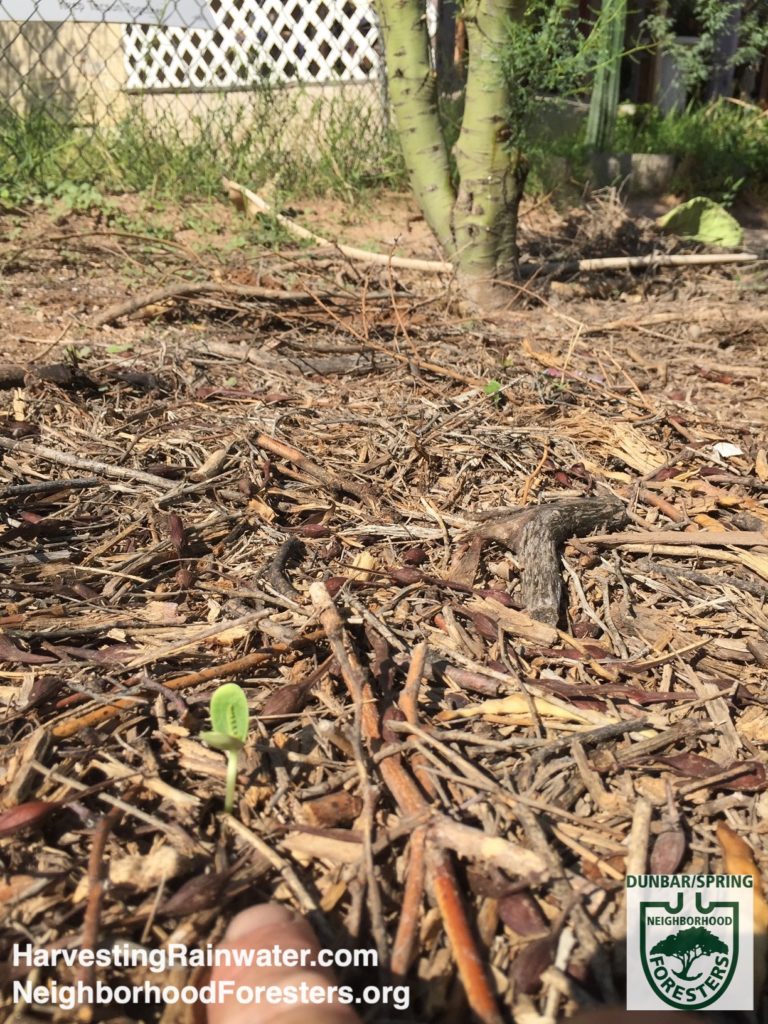
Photo: Brad Lancaster, 7-2017
The transplanting couldn’t wait. Such transplanting works well when the soil is moist, soft, and holds together around tender young roots; but typically fails when the soil is dry, hard, and crumbles off roots when disturbed with a shovel. (It is also delightful to be out and about just after a refreshing rain). But there was no more rain in the forecast. I had to act.
Turning a problem into a solution
I began beside the parking lot of a student housing complex a block away, which has long irritated neighbors with the heat radiating from the bare asphalt and the glare from the overhead parking lot lights. There are many bare spots where the apartment’s non-native trees (poorly adapted for our local climate, soils, and wildlife) have died out over the years, blown over in a storm, dehydrated in a drought or temporary irrigation system failure, or frosted out by a winter cold spell.
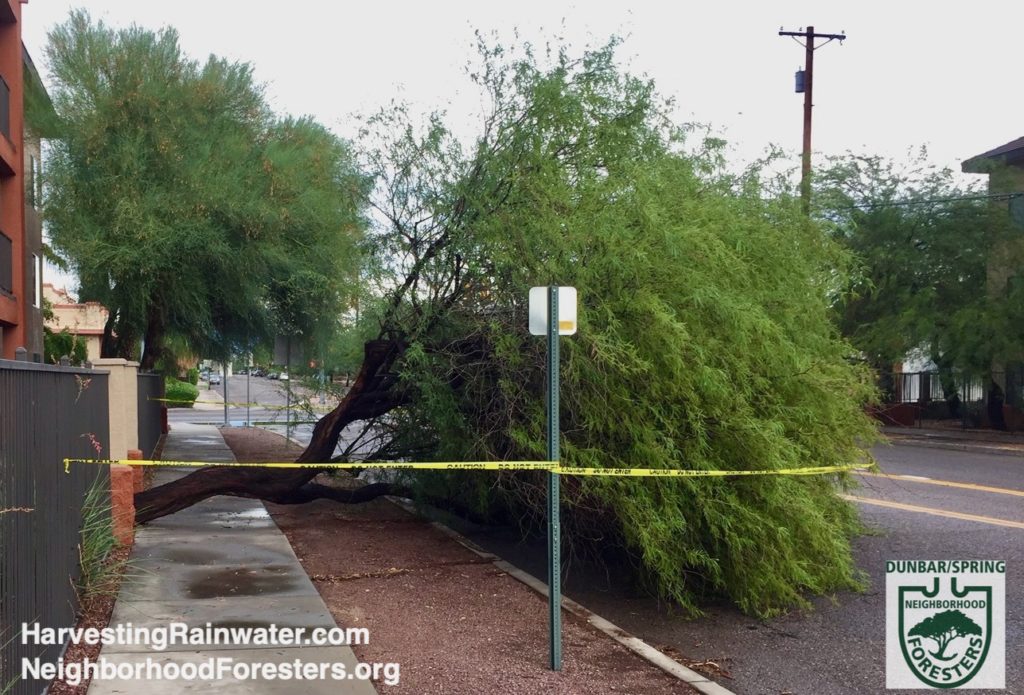
Such non-native South-American hybrid or “Chilean mesquites” are very prone to such blow over or “windthrow”, and their roots tend to heave adjoining pavement.
Native velvet mesquite (Prosopis velutina) does not have these negative characteristics.
Photo: Brad Lancaster
I look for drip irrigation emitters lacking a plant or having a dead stump where there once was a plant. Then, with the blessing of the property manager, I make a basin shape in the soil to collect, rather than deflect, the rain. Where feasible, I make the basin deep enough to also collect stormwater runoff from an adjoining surface such as a roof, path, or street. Within the basin I plant the seedling, arrange the irrigation emitters to best support the seedling (each emitter progressively a bit further from the seedling to encourage its roots to spread out further), then I give the seedling and its basin a good drink by filling it with water from a 5-gallon (20-liter) bucket. (I don’t know when, if at all, the drip irrigation system may next emit water). Finally, I encircle the baby tree with rocks to show that someone cares about this plant. Someone wants it here. And perhaps ask, “Could you please let me be? Or even help care for me too?”
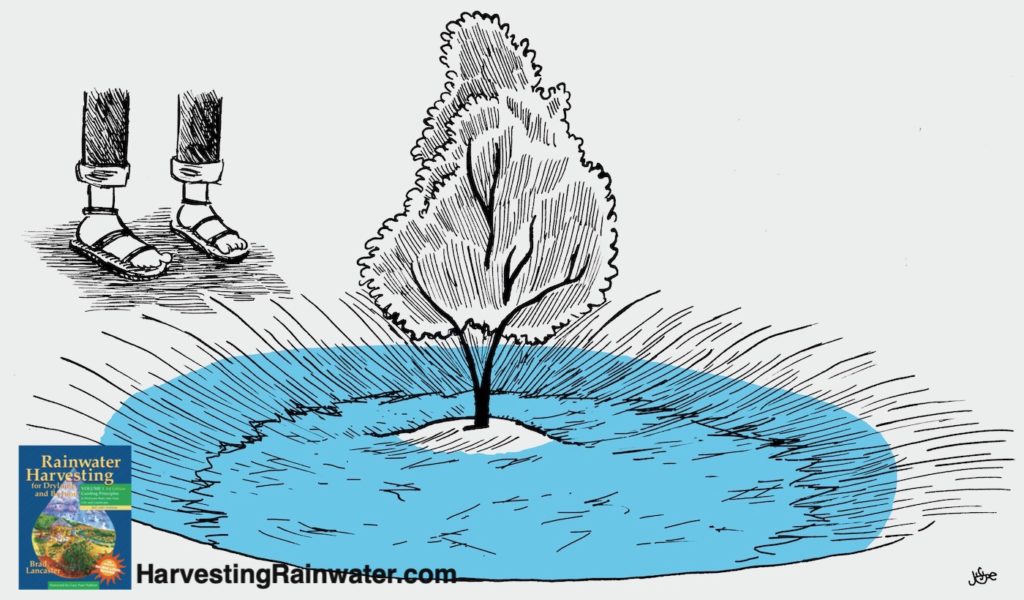
Illustration: Joe Marshall
Reproduced with permission from Rainwater Harvesting for Drylands and Beyond, Volume 1, 3rd Edition.
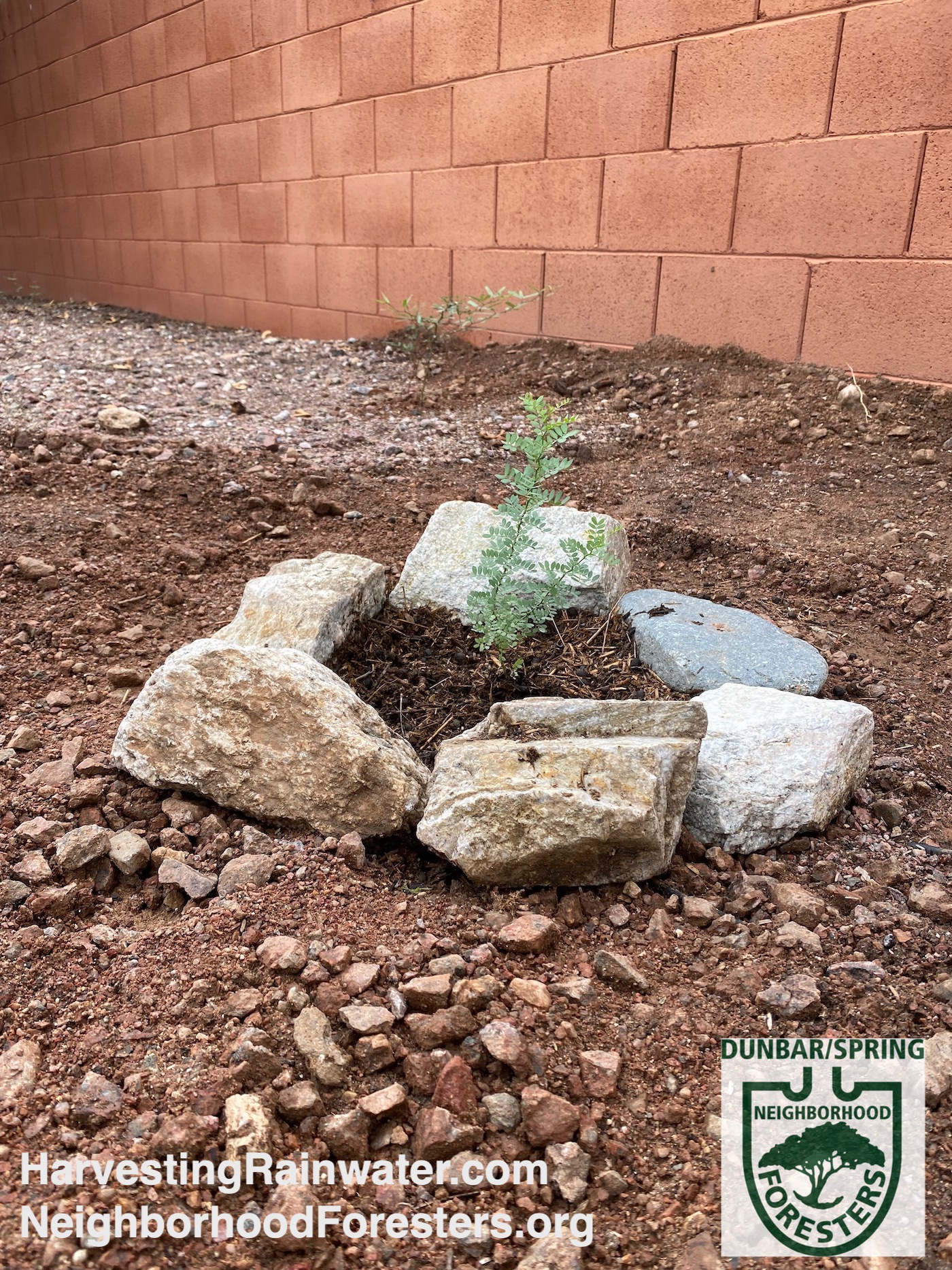
Photo: Brad Lancaster
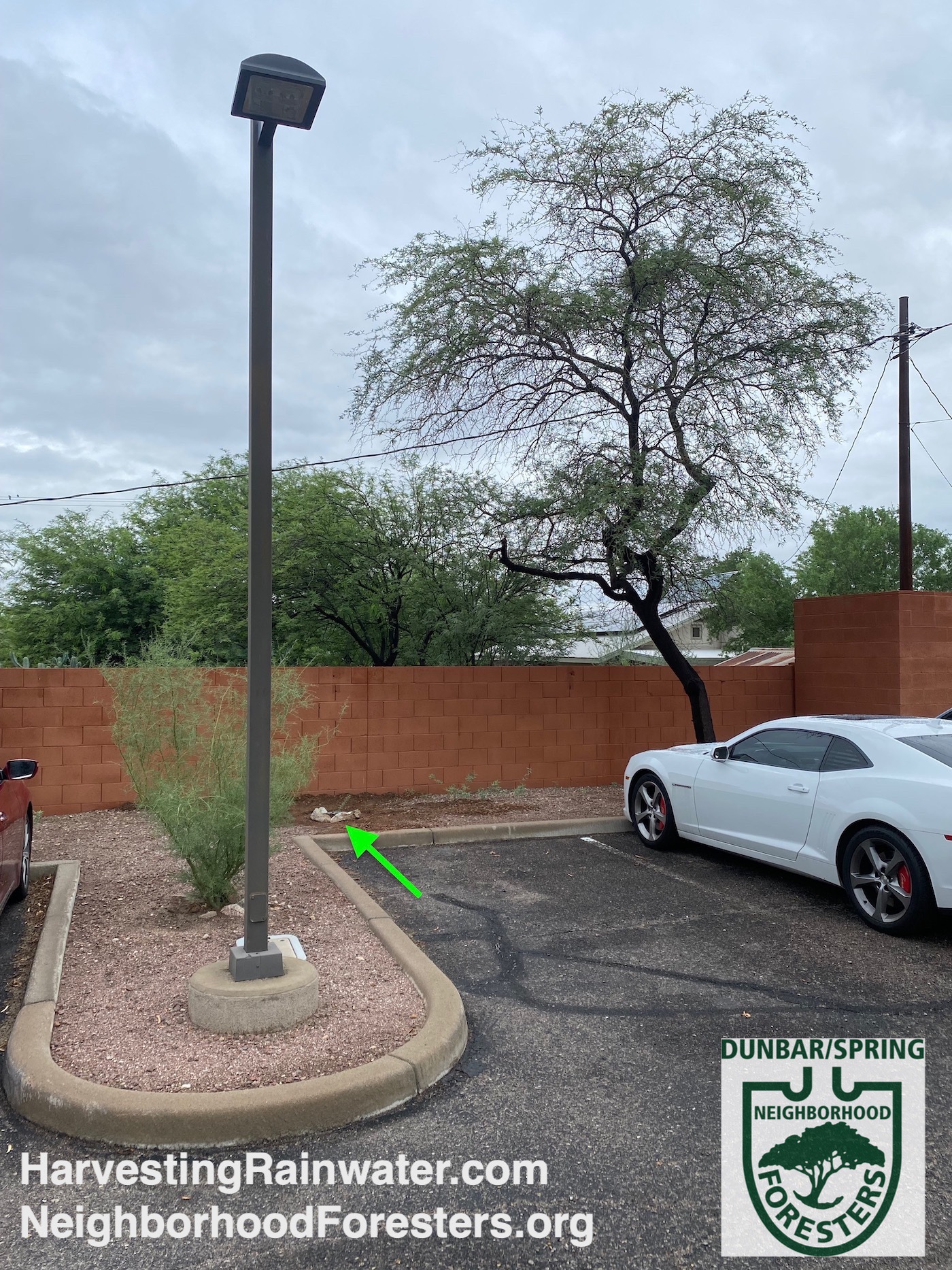
Note the ring of rock at the base of the green foothills palo verde tree just behind the light post. I planted it as a seedling years ago. So far, so good!
The hope is both trees will grow to buffer neighbors from the light, noise, and heat pollution emitting from the parking lot, while also shading and cooling the students using the parking lot.
Photo: Brad Lancaster
Asking for permission or, if needed, donning camouflage
Where I have, or can strike up, a conversation and a relationship with the landowner or a caretaker, I get their permission. It may go something like this, “Hi, I’m a neighbor of yours from right around the corner. My name is Brad, and I’m part of a neighborhood foresters effort striving to green up our community, and I was wondering if you’d be up for a tree? I could plant it for you, or with you, for free. And I can do so in a way that it won’t incur you any additional maintenance or costs. Or even better, I can show and help you with a few caring tips that will ensure it won’t just survive, it will thrive.”
But in abandoned spots or where an adjoining absentee landowner is unresponsive, I might just plant first, and do so early in the morning, dressed like a landscaper, so as not to attract unwanted attention.
I listen to life and death as I work
Birds and insects sing while I plant, doing so from maturing plants neighbors and I planted years before.
While screaming mechanical weedwackers and blowers or green dye-stained herbicide crews kill and remove “weeds” trying to emerge on the other side of the parking lot. Sometimes it’s the roar of a chainsaw cutting down a fallen branch or tree.
How can I better ensure the seedlings I transplant will grow to be assets and seen as such? Unlike fast-growing non-native trees that are prone to losing branches or blowing over in storms, I plant hardier, slower growing, native trees that better withstand our weather. I select species well-suited to the microclimate in which they are being placed. Lower-water-use plants where there is less water, higher-water-use plants where there is more water, thorny plants set back from where they might otherwise grab a passerby, and only deep rooting species near pavement to ensure the roots will never crack nor heave the sidewalk, curb, or asphalt. I also look to our local ethnobotanical history to select plants that produce food, medicine, craft materials, and superior wildlife habitat.
For some examples see the plant appendix in Rainwater Harvesting for Drylands and Beyond, Volume 1, 3rd Edition.
Easier still, plant the rain, then plant seed
Easier than transplanting seedlings, is to plant seed directly in the earth where I want it to grow. I first create a rainwater-harvesting earthwork or basin (ideally where runoff from adjoining surfaces can also be captured to maximize available rainfall). This is most pleasant to do in our cool months. Then I return in the hot dry season, just before the summer rains begin, plant the seed within the earthwork, and walk away. If enough rain falls, the seed will germinate, and manage on its own.
The success rate is great, because the passive water harvesting ensures there will be ample water. And the seed I choose is from hardy, multi-use plants native to my place, and thus are the best adapted to our soils, climate, and wildlife.
I should probably do all, or almost all, my guerilla planting this way; so why don’t I?
Well, in the dry, dormant months I’m just not as motivated as I am when rains are falling and the plants are erupting with verdant new growth.
And sometimes, I’m out of town for the beginning of the rainy season.
See this video, and the Tips on collecting seed and Tips on propagating from seed at the end of this essay for more.
Stewarding to leverage success
I come back periodically after planting, and prune the plants if needed, to ensure they don’t grow to block a pathway or parking space. Or if I’m late, and someone else has already pruned, but in a damaging way, I attempt “corrective surgery” in the form of strategic pruning cuts that can minimize the damage, enable quicker healing, and set a better example for pruners in the future. Our Neighborhood Foresters group has regular pruning workshops (open to anyone) with certified arborists to train folks in good pruning techniques and how to correct bad pruning work. And we use many of the prunings for neighborhood goat feed.
I pick up trash from around the planting, so this is a bright spot of the landscape and does not call in a “maintenance crew.”
In the first year of growth, I may also bring an occasional bucket of water (once a week in the hot months) if the rains haven’t come, or the irrigation system no longer comes on. Here’s a video of similar efforts.
I love this stewarding, and checking in with vegetative kin. We help each other. Though I feel the seedlings do the vast bulk of the work as they grow, break up and enliven the soil, produce oxygen, turn carbon into food, lure and feed pollinating wildlife, …
Here are a couple of successes…
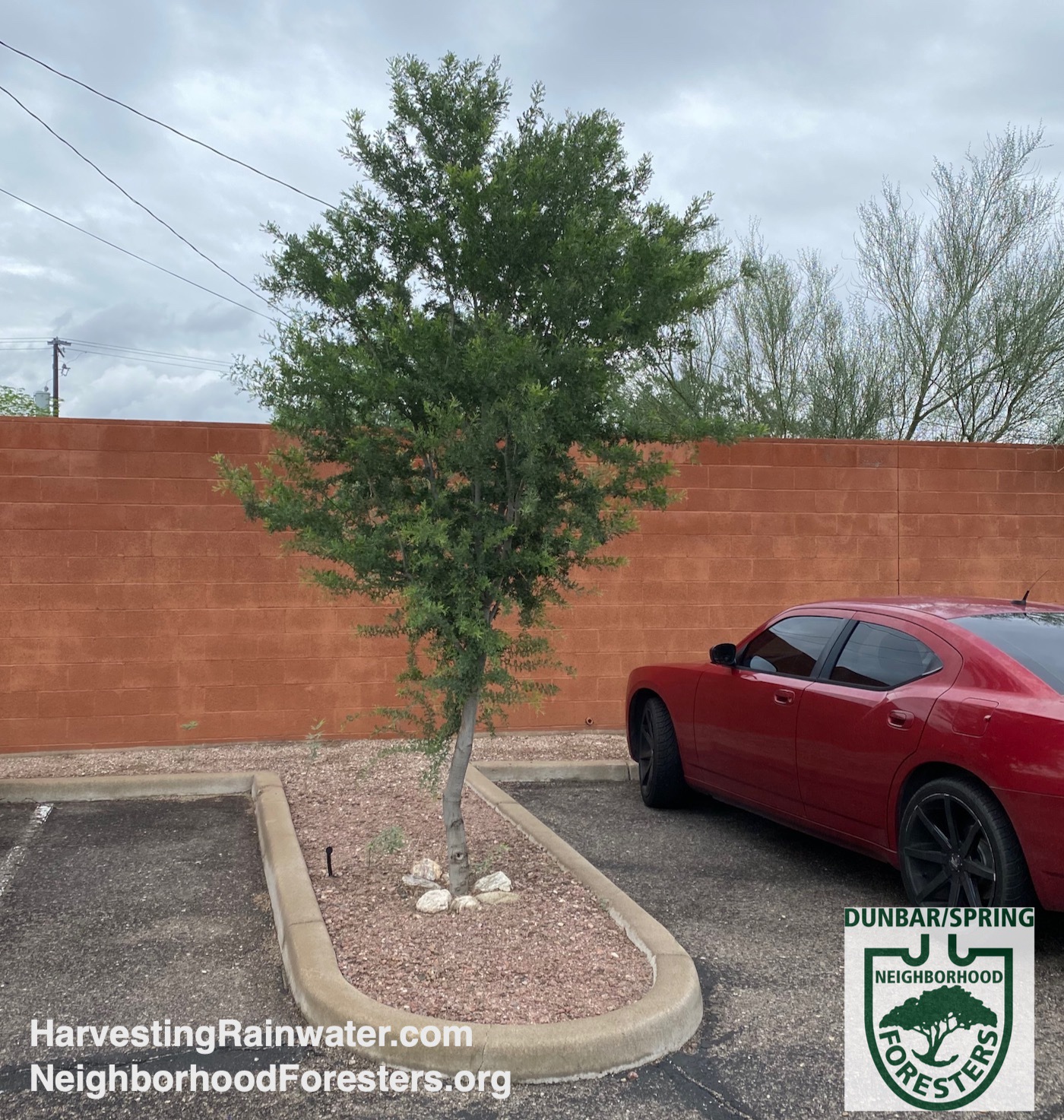
Photo: Brad Lancaster, 8-2022
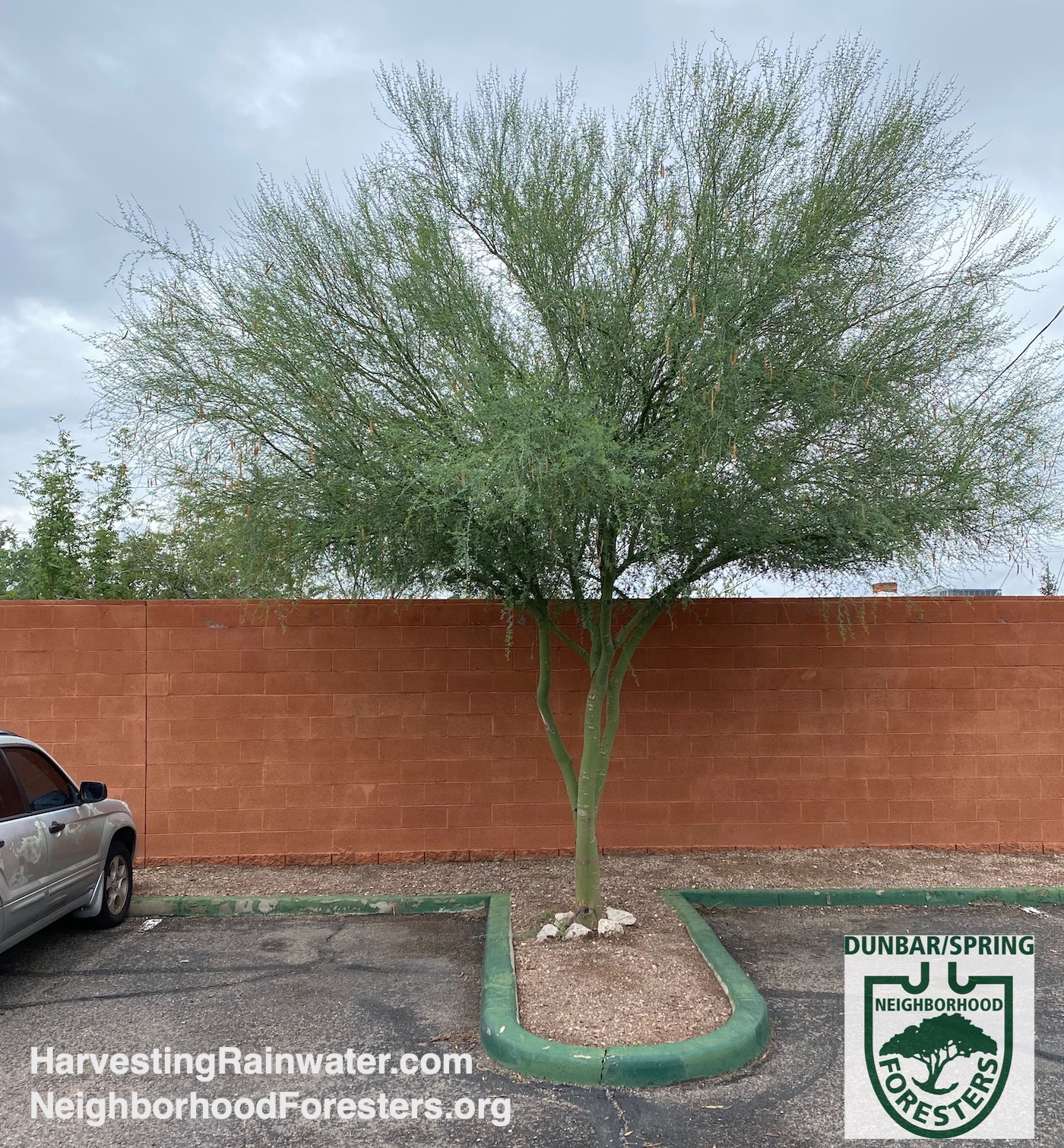
The ring of rocks at the base of the tree can now be used for a new seedling elsewhere.
Photo: Brad Lancaster, 8-2022
A practice of inviting hope and letting go
This work is more pleasureable, and I’m more likely to do it, if I let go of my expectations, or at least my fears. It’s like a punch to the stomach when I see a planting cut down, run over, herbicided, or maimed/killed in some other way. But I’m lifted back up when I instead focus on the plantings that are still surviving and thriving. And so, I plant a lot, not necessarily all at once, but over time, to better the chances that some will make it. Even just one of many plantings surviving is a success. It’s better than when there were none. (Though I’ve now been able to get my success rate up over 80% after trial and error).
I’m inspired by the poem “Torture” by Alice Walker, here’s an excerpt…
…
When they torture you
too bad
to talk
plant a tree.
When they begin to torture
the trees
and cut down the forest
they have made
start another.
If I were to think of a plant’s potential future demise, I’d never act.
So, I instead focus on the wonder that is, and that could be.
I feel immense gratitude when I plant. Gratitude for this life, this moment, all the lives and conditions that enabled me and this seed or seedling to even be, and what I am learning and experiencing as I strive to collaborate with this flow. I also feel hope and gratitude for what may yet come to be, and what I may still learn.
Such was the case when I dug up a desert ironwood seedling recently, and discovered a dense mat of white hair-like hyphae or “roots” of mycorrhizal fungi growing within and beneath the organic duff atop the soil. This fungus thrives in, and helps decompose, dead woody matter and leaf drop; while fusing with the roots of plants to give them water and minerals in exchange for sugars from the photosynthesizing vegetation. The fungi also act like a subsurface internet enabling plants and other soil life to communicate with each other and exchange water and nutrients as needed. By transplanting seedling, duff, and fungi together, the seedling would not be alone. The collaborating lives would better enable a new hub of collaborative life more likely to succeed and grow.
But there are failures and losses, so I minimize that hurt by planting in a way that costs me no money. And I strive to maximize the gain—often by planting from seed or seedling I’ve freely collected from favorite and alluring spots of life. I’ll do so solo when I need some introspective meditation time. Or I reach out to a friend, neighbor, or family member when I feel one or both of us is needing to connect. Other times I may bring a new person or few I want to get to know better, and show them how to plant free-style. We may plant directly in the ground, or in a pot in my backyard nursery from which I or we will later transplant to other areas when the time and place is right; such as when another neighbor requests or accepts a plant, and agrees to take care of it.
I also organize occasional workshops, work parties, baby saguaro sales/planting, and an annual planting of rain and native food forests to widen the net of collaboration and support.
Not all the planting I do is for free, some is for pay, or trade when the scope of work is larger, more complex, or further from home. I’m always recalibrating that one, striving for balance. How can we best support one another, without over extending, or burning out? How best can we grow ourselves, forest, and foresters in a healthy and reciprocal way?
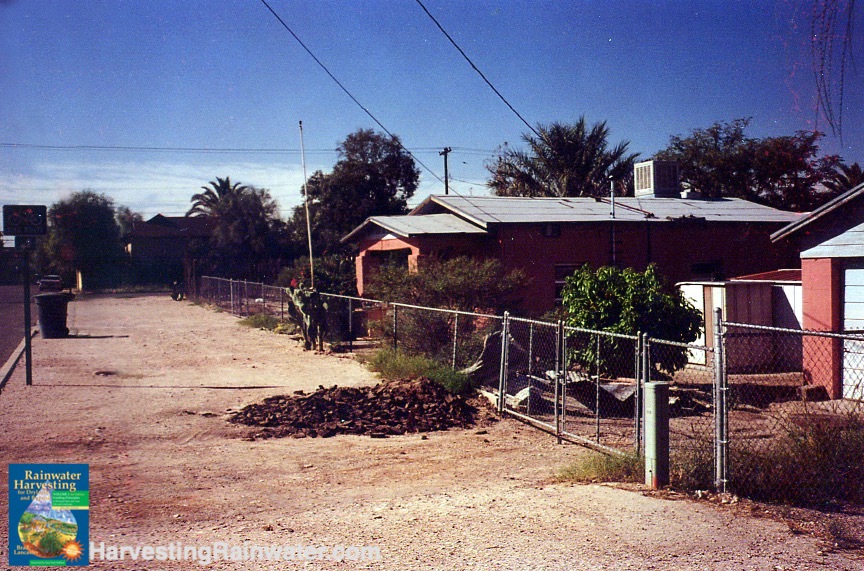
Reproduced with permission from Rainwater Harvesting for Drylands and Beyond
Photo: Brad Lancaster
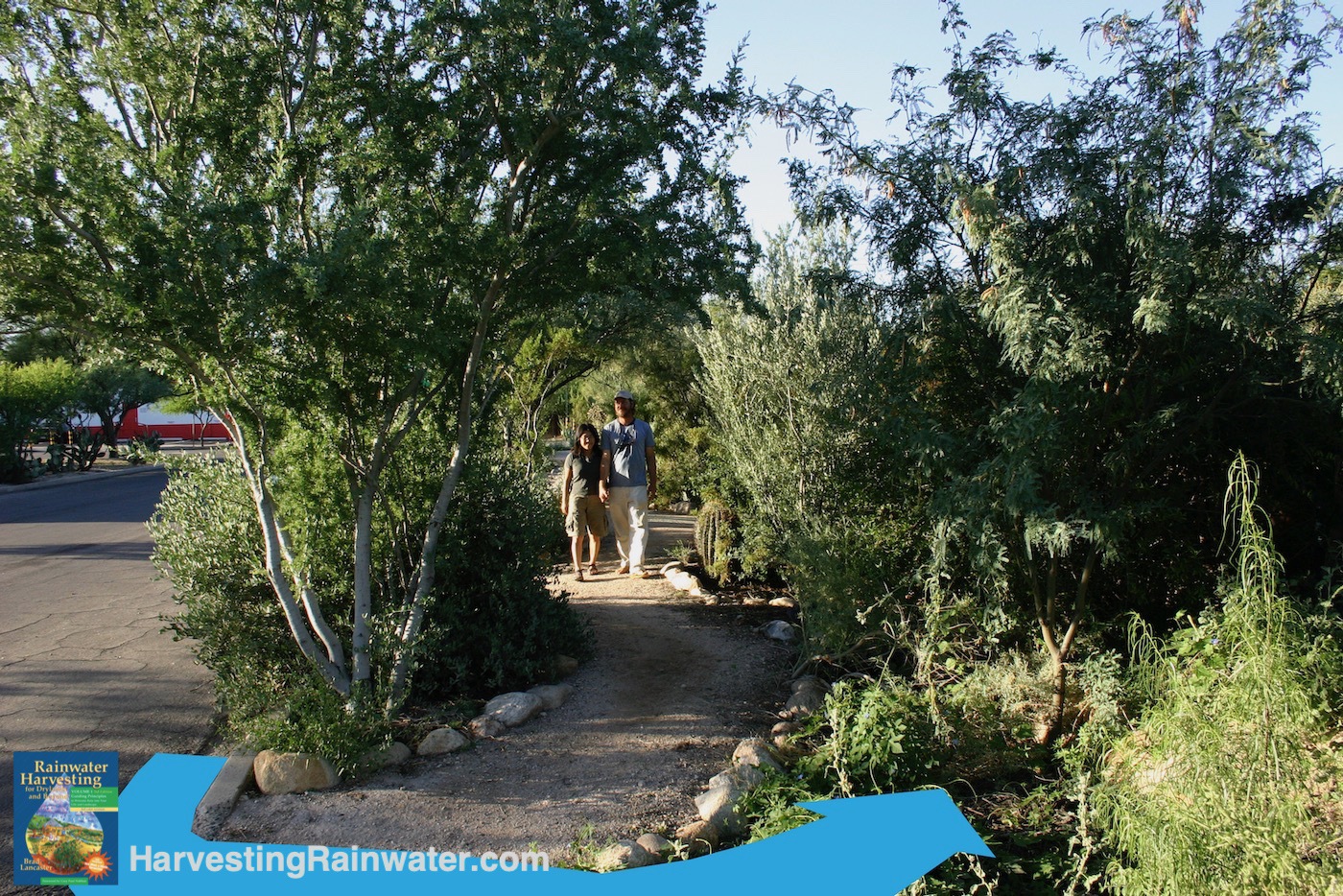
Reproduced with permission from Rainwater Harvesting for Drylands and Beyond
Photo: Brad Lancaster
Failures can become successes
A lot can be learned when a plant is killed, maimed, removed, or dies on its own. And if we are open to that learning, we can dramatically improve the chances of the next planting surviving.
Drunk drivers driving into our neighborhood’s water-harvesting traffic calming round-a-bouts offer such an opportunity. I’m grateful when such drivers get their vehicles ensnared by our infrastructure since they cannot then continue on to collide with, and hurt or kill, others. Post impact, I assess the damage, and observe what plants can, or cannot, recover from major harm. Those that have the ability to resprout after being cut down to a stump, turn out to be great coppice species, and I then consciously plant them in locations where a plant is needed, but is also more susceptible to potential future harm.
Desert ironwood (Olneya tesota), velvet mesquite (Prosopis velutina), blue palo verde (Parkinsonia floridum), desert hackberry (Celtis pallida), creosote (Larrea tridentata), desert honeysuckle (Anisacanthus thurberi), prickly pear (Opuntia spp.), cholla (Cylindropuntia spp.) are some of the species I’ve found resilient to coppicing.
Here’s an attempt that had been cut to the ground, but may yet succeed…
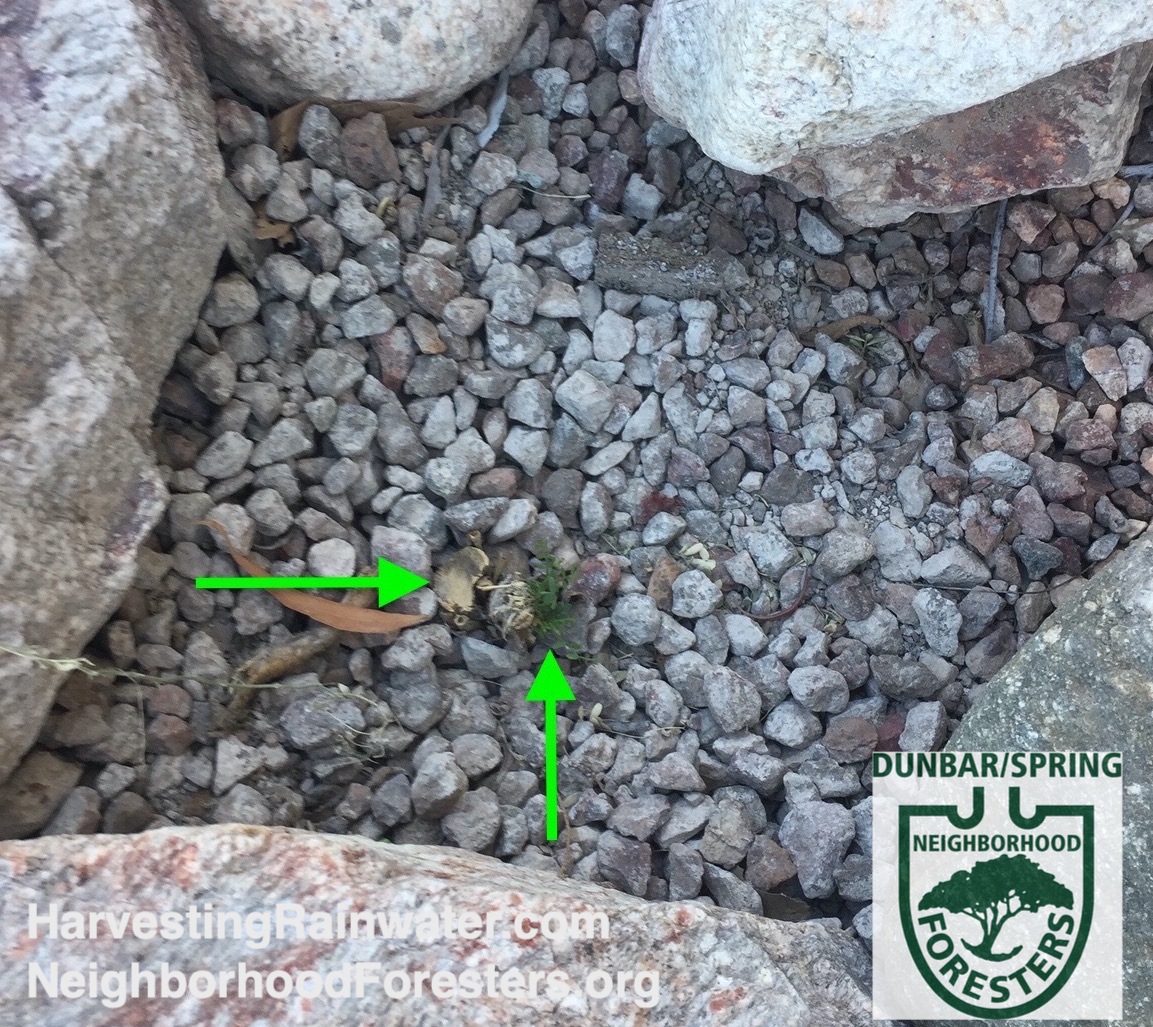
It had been planted eight years prior as a 6-inch (15-cm) tall seedling, quickly grew to three feet (1 meter) tall, then was repeatedly topped or cut back into an 18-inch (0.5-m) tall shrub for a number of years by landscape crews, before they finally cut it to the ground.
Arrow in center points to new growth emerging from the second stump.
Photo: Brad Lancaster
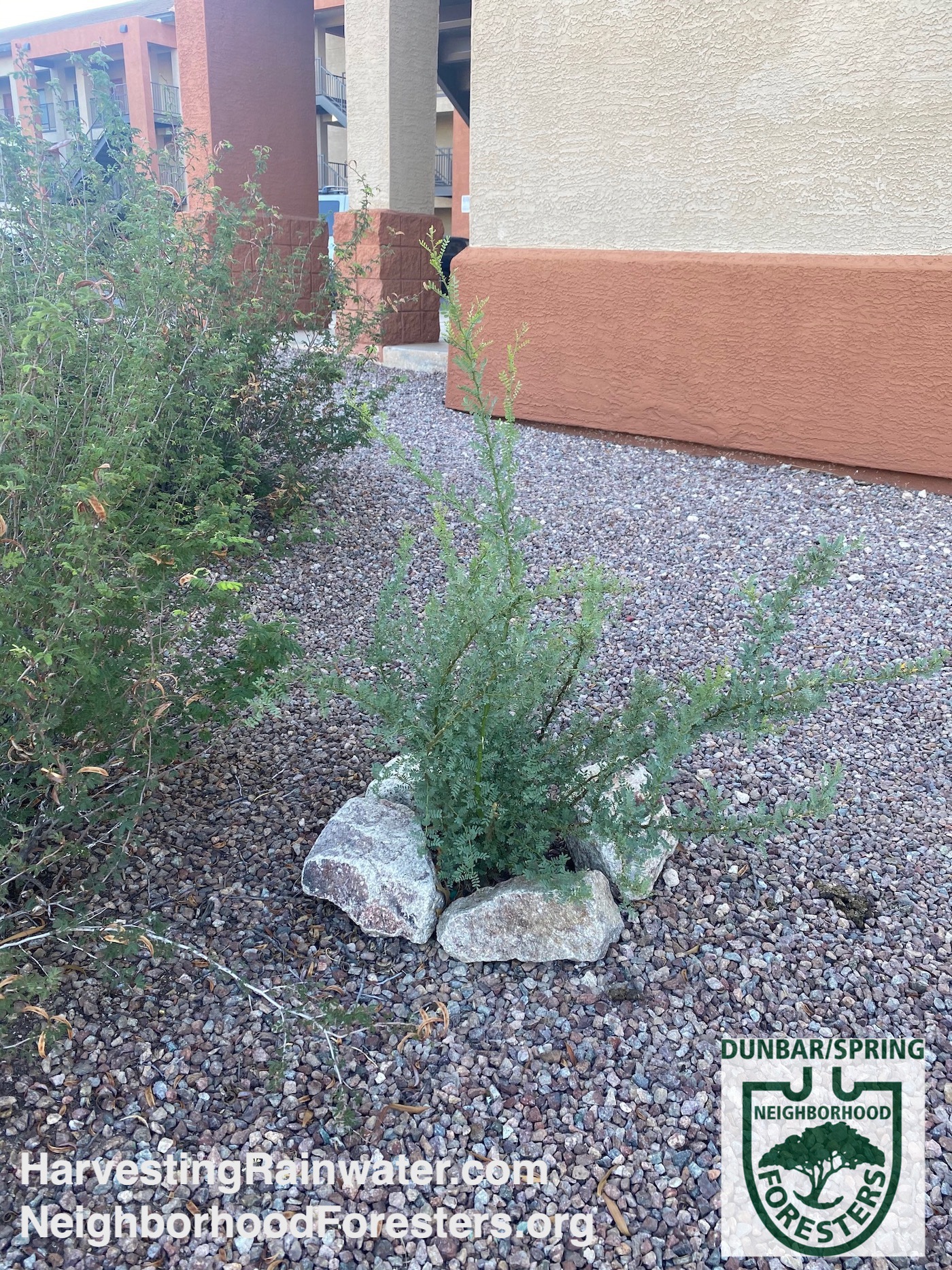
Photo: Brad Lancaster, 7-2020
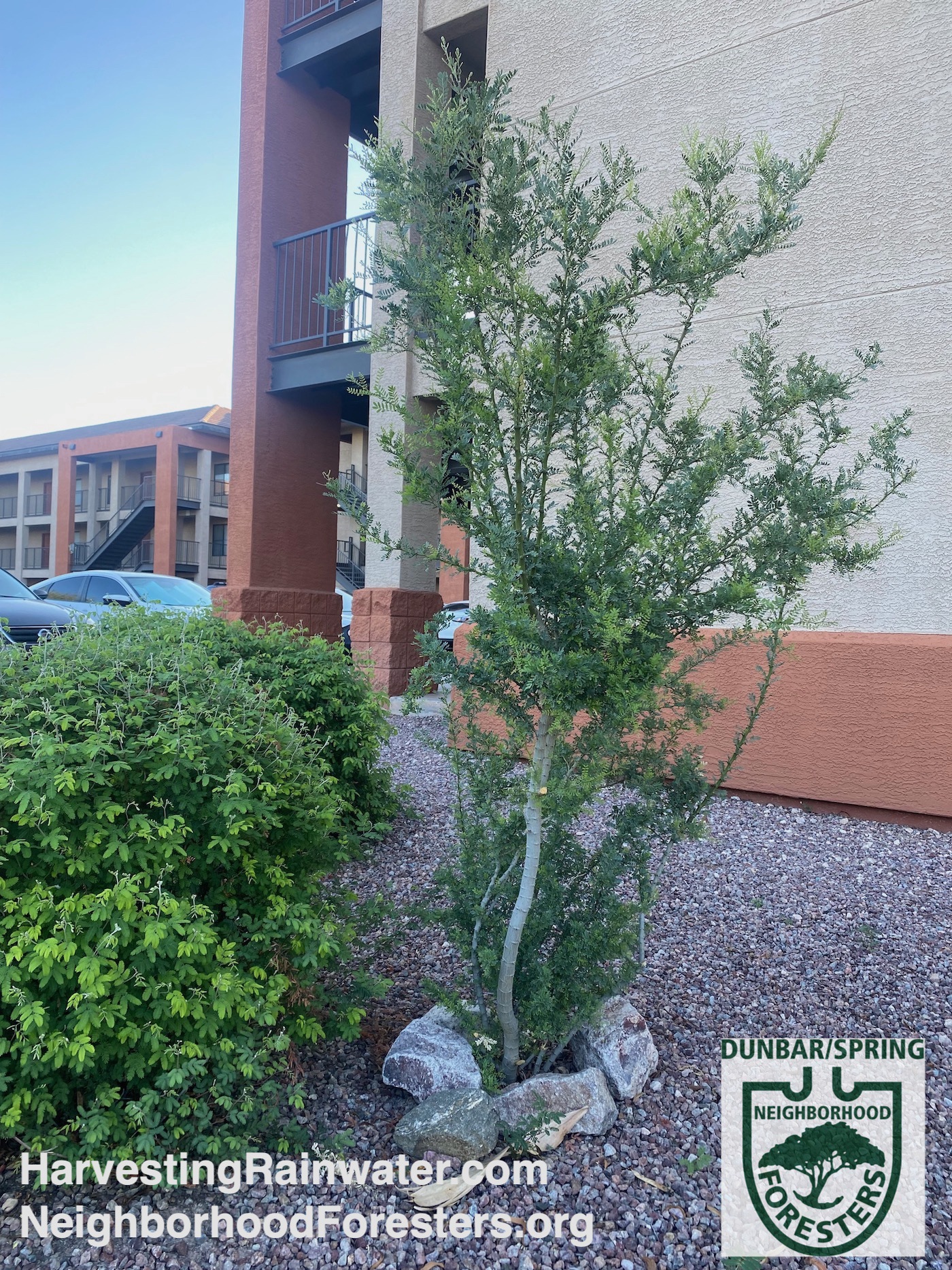
It is now five feet (1.5 m) tall. Fingers crossed. This just might be the year this desert ironwood gets to grow to be a tree.
The fairy duster shrubs beside the tree got unnecessarily pruned into balls, but thankfully the tree was spared this time.
Photo: Brad Lancaster
Even if a plant does not resprout from damage, herbiciding, or other, I’m still better off to try again
The planting spot, basin, and rock are already there. I can retry with a different plant perhaps better suited to the spot. For example, if the spot was drier than expected, I’ll next plant a more drought-resistant plant. If the spot was wetter than expected, I’ll replant with a more moisture-hardy/needy species. A great way to learn about the microclimate preferences of a plant is to go out in the wild and see where these plants naturally grow, and what microclimates they prefer. Books about your local flora can also help, along with local plant nurseries. Here’s some resources I like for my area.
Sometimes people will remove a live plant when they think it is dead. This can be the case with plants that are winter deciduous (drop their leaves in the cold months) or drought deciduous (drop their leaves in the dry months or drought). If I’m not able to enlighten the removers about the deciduous nature of the plants, and how they will rebound with leaves and more life in the appropriate season if left alone; then I’ll replace the removed plant with an evergreen species that never drops its leaves.
Agaves (easy to transplant from pups growing around the mother plant if she’s an agave murpheyi) or cacti (easy to propagate from cuttings) work well in spots often herbicided as herbicide crews typically don’t herbicide these plants (they don’t look anything like a typical weed). And even if they are herbicided, they sometimes recover. (If I happen to come upon a plant right after being herbicided, I’ll promptly rinse off the poison by pouring a bucket of water over the plant. I’ve had good success when the rinsing occurs the same day as the herbiciding (sooner the better).
Compound interest from a little guerrilla planting
July 2022 I planted 30 trees and 15 understory plants from seed. Thus far in September 2022, I’ve transplanted 40 tree seedlings, and 20 understory plant seedlings.
Financial cost: Zero
Just did a little planting each morning when I woke up as a practice of meditation, joy, and collaborating with life bigger than me.
Potential square footage of living shade that may result as plants reach maturity: 22,700 square feet (assuming trees grow to 20’ diameter and understory plants grow to 5’ diameter).
Temperatures in the shade of that vegetation’s canopy is over 10˚F (5.5˚C) cooler on sunny days, and moisture lingers far longer.
And these plantings will produce thousands of seed each year—a living seed bank and nursery.
That’s a massive benefit from just one or two people casually guerrilla planting for just an hour or two every other morning in a single month, then following up with occasional stewarding.
The numbers grow exponentially with more people and more time.
You just have to start.
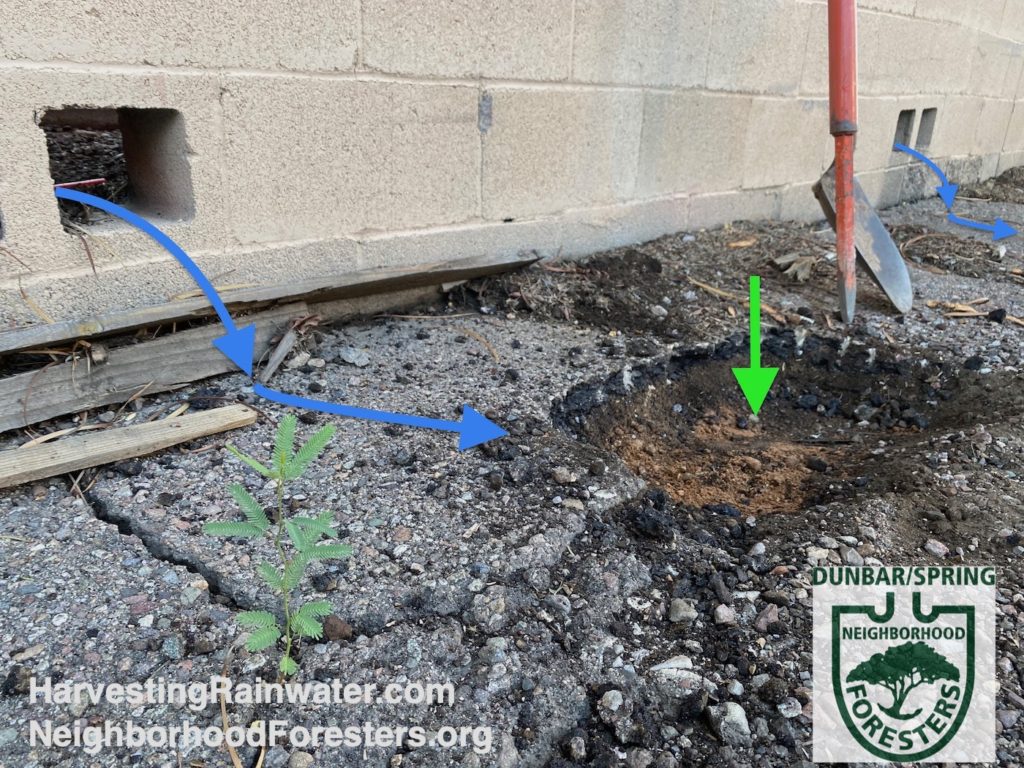
Blue arrows denote stormwater flow from parking lot on other side of wall.
Green arrow denotes where new plantings will go where asphalt has been freshly removed.
Photo: Brad Lancaster
Count some of our official, non-guerrilla neighborhood plantings, and you get these numbers
In the past twenty-five years my neighbors and I have planted the rain with many water-harvesting earthworks that now capture over one million gallons (4.5 million liters) of stormwater per year that used to wastefully drain away.
On average, we are currently expanding our neighborhood’s public rights-of-ways passive water-harvesting annual capacity by over 30,000 gallons (136,000 liters) per year. We are able to create much higher capacity systems than we do with guerilla installations, because we don’t have to be near invisible. Instead, we are striving to be very visible and inspirational (which is in part why we focus such work in the commons, or public land).
Within and beside these water-harvesting earthworks we’ve planted over 1,700 native, food-bearing trees and thousands of multi-use native understory plants (which became the living seed banks for much of our guerrilla plantings’ seed and seedling collection). Now established that the plants are established, the passively harvested water provides all their needed irrigation free of charge, and in a way that enhances and recharges our local water resources (and those of our larger watershed), instead of depleting them.
This has helped evolve city policy, which now requires the similar harvest of street runoff in new road construction and renovation (though this work still has plenty of room for improvement).
Get more info on how to do all this, and a whole lot more, in my books Rainwater Harvesting for Drylands and Beyond and the website NeighborhoodForesters.org
Singing hearts and starts
My heart and others’ sing while planting, stewarding, and seeing life grow and diversify. More butterflies flutter and birds sing. Even long-gone roadrunners, quail, owls, and javalina have come back into the neighborhood as their habitat has been regrown. Students smile as they walk under the growing canopies of shade. Neighbors and I harvest hood-grown sweet mesquite pods, nutty ironwood seeds, palo verde green beans, and more. So do our goats. Folks that see us ask us what we’re doing, we explain, give them some to taste, eyes widen, minds open, drool flows.
Rains come, seeds and seedlings are again plentiful, and the wind, wildlife, stormwater flow, and people all help distribute the seed and seedlings wider and shift them to spots where they won’t just survive, they’ll thrive.
As the living canopy expands, downstream flooding decreases thanks to the living cisterns of vegetation and their associated soil life absorbing, rather than draining the rain gift falling from the sky. That vegetation also creates a swaying roughness atop our planet’s surface that buffers, deflects, and calms violent winds in storms. Growing resilience.
But we’re not done, not even close. The need and potential are massive. There is still so much more for us to learn, and ways we can evolve. We are just barely getting started. And starting feels so much better than not.
_____________
I want to know what you think
What do you think of this essay?
What worked for you?
What didn’t? And why?
Would you like more?
Would you like something different?
You can let me know at brad@harvestingrainwater.com.
I’m wondering if this may grow to be part of a book.
It could evolve into a narrative, a collection of stories, stories of people taking positive action in collaboration with place, perhaps focusing on the unique places, people, and other lives where they live.
___________
Want more info? Keep reading…
An Evolving set of Principles for Guerrilla Planting
• Seek out sites most in need of life.
So, you can help turn those exposed problems into sheltered assets
• Seek out where, and how, in these sites you can best collaborate with life.
Start in the spots that are, or could be, better watered (free on-site waters such as rainfall, stormwater runoff, greywater, air conditioning condensate, evaporative cooler bleed off, etc. are the ideal. Plant those waters with passive water-harvesting earthworks before you plant plants).
Start where you, or someone else, can and will steward the planting.
Get permission where you can. Start where your plantings will be out of the way, protected, or at least not in conflict (with foot or vehicular traffic/access, above or below-ground utilities [you can call 811] to have underground utilities freely marked. Under power lines, only plant what will not grow into the power lines. Bush trees are often a good choice.
If in doubt, use a plant native to your area and microclimate, as it will be the best adapted to your local soil, climate, and wildlife.
Plant polycultures, not monocultures. There is more resilience with greater diversity.
Work and play with others.
• Start small, so you’ll start.
With each planting done you’ll gain more understanding and confidence for the next one. If a planting doesn’t succeed, replace it.
• Be, and recruit other, long-term steward(s)
Go back to past plantings, to see what is working, what is not, and learn how to best respond. Get to know, and evolve with, your plantings, neighbors, and climate.
• Strive to continually enhance the potential of your efforts and the value of your offerings/collaborations.
What do you need to learn and experience? Get on it, try. Seek out others in the know.
Don’t know how to prune? Seek out, or organize, a workshop from a knowledgeable certified arborist. Don’t like the teacher, find another one (we all respond differently to different teaching styles and personalities).
Don’t know your plants? Learn from local plant books, plant nurseries, botanical gardens, local national or state parks, botanists, herbalists, and primitive skills enthusiasts. Here are some resources in my area.
Seek out local native plants with multiple uses and multiple lures by which more people will appreciate and value them. Seek plants that produce food, medicinals, craft materials, fragrance, beauty, superior wildlife value, livestock fodder, etc.
Plant in ways that will require the least amount of expense, while maximizing health, shelter, and life.
Spend ample time in nature learning (what grows in different microclimates; when do different plants germinate; when are their flowers, fruits, and seed ready for harvest; what wildlife interact with different plants and how, etc.)
______
Tips on collecting seed
• Collect seed from plants with desired characteristics:
vigor (which look the healthiest), flavor (each individual plant of the same species can have its own unique flavor—choose what you like), abundant harvest (some plants produce more than others or in dense, easier to pick, clusters), ripening time (you can extend the harvest with plants that ripen at different times, or—as is the case with mesquite pods in the low, hot desert—its best to harvest from trees whose pods ripen before the summer rains to avoid invisible molds and aflatoxin). When collecting seed, you only know one of the parents—the one you’re harvesting from—so there is always variability when you grow from seed. That’s why I plant more than one seed in each pot or area. As the plants grow, I can observe their characteristics and thin (remove any undesired plant, while leaving the desired one) as needed.
• Collect from many different plants to increase the diversity of the gene pool.
• Avoid unwanted hybrids.
Some plants hybridize with different species. For example, our native velvet mesquite trees (Prosopis velutina) readily cross-pollinate and hybridize with introduced non-native mesquite trees. But the flavor of the native mesquite trees’ pods, and the diversity of native wildlife the native trees can support, are typically superior to the non-native trees. So, I harvest native mesquite tree seed in areas far from where any non-native mesquite trees are growing to avoid unwanted cross-pollenization (honeybees can fly up to six miles). I do the same for foothills palo verde trees (Parkinsonia microphyllum), as I recently discovered they can hybridize with introduced palo brea trees (Parkinsonia praecox).
• A great local source of native seed is Wildlands Restoration. Native Seeds/SEARCH and Spadefoot Nursery sell their seed.
______
Tips on propagating seed
• I plant the seed when I see it germinating in the wild. This is typically with the first good rain of the rainy season. Though some species prefer our summer rainy season, while others like our winter rainy season.
• When planting native plant seed, I plant it in native soil (I don’t buy any potting soil), though I may amend the soil with a little fertile organic duff collected from under a healthy native tree. I figure the native plants have adapted to our native soils – not artificially amended soils.
• Soft seed vs hard seed – to scarify or not.
Soft seed (like that from desert ironwood trees) I plant as is, while hard-coated seed (like those from palo verde and mesquite trees) I plant some seed as is, and some I scarify by nipping it with toe nail clippers just enough to barely break through the seed coat in one spot on the seed’s side (then I see which germinates better). The hard seed coat protects the seed from drying out, and scarifying happens naturally when passing through an animal’s gut or tossing about with sand and other sediment in stormwater runoff flow. For hard seed too small to nip, I may just pour a cup of boiling water over the seed (to kinda mimic the passing through an animal’s gut) just before planting.
• I plant the seed where it will get rained on, or even better where it will also get water running off an adjoining surface to increase the amount of available rainfall. If there is enough rain, the seed will germinate.
• When planting directly in the ground, I also plant in an area that is protected from foot traffic, getting run over, or trampled. Protection could be provided by an adjoining fence or wall, another good-sized plant, water-harvesting earthwork, a ring of rocks (like I place around transplanted seedlings), etc.
• Once the seed has germinated, if the rains are good, they take care of all the watering. But if we have a hot, dry spell I’ll give the seedlings some supplemental irrigation (typically from my rainwater tank). Seedlings in pots typically need more supplemental irrigation. While seed planted directly in the ground at the beginning of the rainy season—where I’ve also planted adequate rain and stormwater runoff—typically does not need any supplemental irrigation (the exception would be an extreme drought year).
• I also share seed with local native plant nurseries for greater resiliency (the more folks growing, the more likely someone will succeed) and community building.
_______
Tips on transplanting and stewarding a seedling
• Best to do just after a good rain when the soil is moist, though you can “cheat” and do this in dry times to, by first saturating the root zone of the plant you are about to transplant. I like to do this with a drip irrigation bucket.
Note that the chances of accidently cutting off the tap root of a seedling dramatically increase once the seedling is over eight inches (20 cm) tall—so transplant when they’re small.
• Find a spot needing the plant (a hot, exposed area in need of living shade) that you or another volunteer can easily and conveniently access, to ensure the planting will be stewarded once planted. If another volunteer will be doing the stewarding, get their commitment before you start. And even better, plant the seedling with the other volunteer so you both set roots with the planting, and you’ll both be more apt to look out for its welfare.
• After finding a spot needing the plant, then plant the rain by creating a water-harvesting basin or other earthwork, which ideally will capture rainfall and runoff from adjoining surfaces to increase the volume of available rainfall. Other free, on-site waters you can direct to the water-harvesting earthwork could include greywater, dark greywater, or condensate. See Rainwater Harvesting for Drylands and Beyond, Volume 2, 2nd Edition for more.
• Within or beside the water-harvesting earthwork, dig a hole only as deep and wide as the root ball of the seedling.
• Plant the seedling, carefully pack soil around the root ball to ensure there are no big air pockets.
• Provide protection from foot traffic, getting run over, or trampled. The water-harvesting earthwork can do this. Additional protection could be provided by an adjoining fence or wall, another good-sized plant, water-harvesting earthwork, a ring of rocks (like I place around transplanted seedlings). If predation by animals is a risk, you can also encircle the seedling with chicken wire or hardware cloth.
• Mulch the surface of the soil around the seedling, ideally with duff taken from under a similar mature plant or compost.
• Water the seedling right after transplanting (when the seedling is most stressed). Give supplemental water as needed (typically once per week if it does not rain, saturating the root zone of the seedling).
• Remove weeds that grow up around the seedling, and pick up litter so it is a bright spot in the landscape that people will appreciate, rather than something ugly they might want to eliminate.
See the new, full-color, revised editions of Brad’s award-winning books
– available a deep discount, direct from Brad:

Volume 1
The book to assess your free on-site water sources, then create an integrated plan to harvest them to grow regenerative abundance.
Plant appendix gives you tips on what to plant and how to estimate your plants’ water needs, so they will be in balance with what you harvest.

Volume 2
Step-by-step instructions on how to design, build, and plant many different water-harvesting earthworks for many different contexts.
